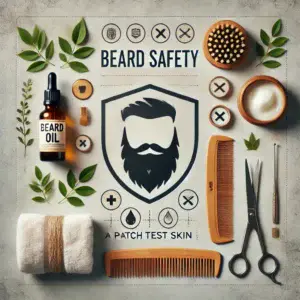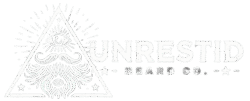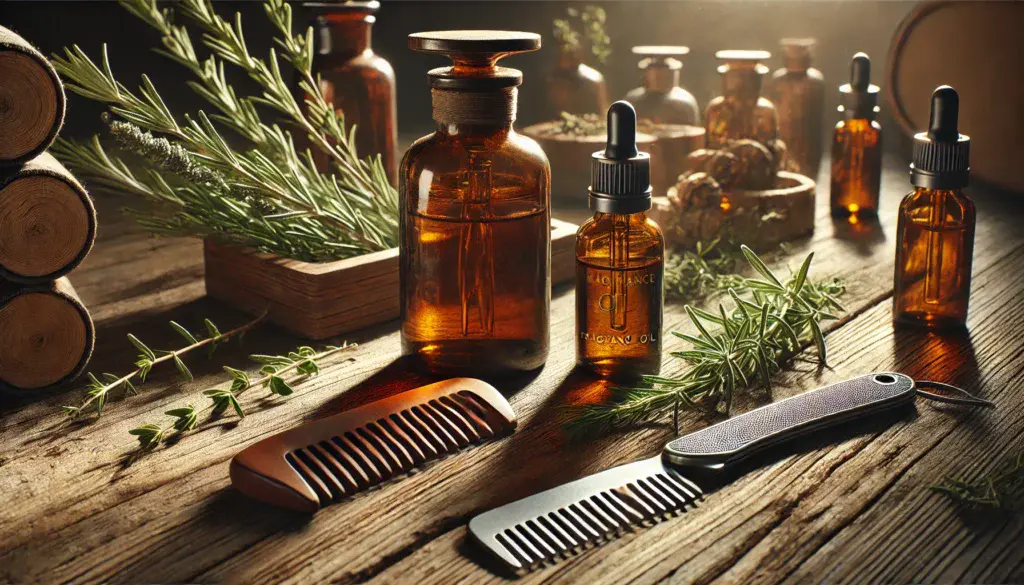Why the Oil You Use Matters
When it comes to beard care, not all oils are created equal. The type of oil you use affects more than just scent—it can change the texture of your beard, the health of the skin beneath, and even how your beard grows over time.
Two of the most common scent sources used in beard oils are essential oils and fragrance oils.
Both bring something different to the table, but knowing which one fits your goals can make a big difference in your daily routine.
If you’ve ever wondered about the benefits of essential oils over fragrance oils, or you’re trying to figure out how to choose between essential oils and fragrance oils, this guide breaks it all down clearly and practically.
What Are Essential Oils?
Essential oils are naturally derived from plants—flowers, leaves, bark, roots, and resins—through steam distillation or cold pressing.
Each plant contains unique aromatic compounds that give the oil its scent and properties. Because they come straight from nature, essential oils aren’t just about smell.
They can also have effects on your skin, mood, and overall beard health when used correctly.
Common essential oils in beard care include:
-
Cedarwood – grounding, warm, and soothing to the skin.
-
Sandalwood – rich, creamy aroma that helps soften hair.
-
Lavender – calming and helps reduce itchiness.
-
Tea Tree – known for cleansing and reducing buildup.
-
Bergamot (FCF) – bright citrus note that uplifts mood without sun sensitivity.
Each of these does more than add scent—they can improve the way your beard looks and feels over time.
What Are Fragrance Oils?
Fragrance oils, on the other hand, are typically synthetic blends made in a lab. They’re designed to mimic natural scents or create entirely new ones that don’t exist in nature.
Think “leather,” “bourbon,” “smoked vanilla,” or “midnight musk.” These oils are consistent, long-lasting, and often less expensive than their natural counterparts.
While fragrance oils don’t offer the same potential skin and hair benefits as essential oils, they excel at one thing—scent strength. If you want your beard to smell bold and noticeable all day, fragrance oils do the job.
Essential Oils vs. Fragrance Oils: Quick Comparison
| Category | Essential Oils | Fragrance Oils |
|---|---|---|
| Source | Natural (plants) | Synthetic or blended |
| Scent Strength | Light to moderate | Strong and long-lasting |
| Skin Benefits | Yes, when diluted properly | Minimal or none |
| Consistency | Can vary batch to batch | Always consistent |
| Cost | Higher | Usually lower |
| Irritation Risk | Possible if undiluted | Possible due to synthetic compounds |
| Scent Variety | Limited to nature’s palette | Endless creative options |
The Benefits of Essential Oils Over Fragrance Oils
1. Better for Skin and Beard Health
Essential oils can actually help the skin and hair beneath your beard. When used at proper dilution levels (usually 1–3% in carrier oils like jojoba or argan), they may reduce dryness, calm irritation, and improve softness.
Because the oils are plant-based, they often come with natural compounds that soothe inflammation and promote balance.
Fragrance oils, while they smell great, usually don’t contain anything beneficial for your skin. They’re added purely for scent, not for nourishment.
2. Cleaner and More Natural Ingredients
If you prefer to keep your grooming products closer to nature, essential oils are the clear choice. They don’t rely on petrochemicals or synthetic stabilizers.
While “natural” doesn’t automatically mean better or safer, essential oils tend to be simpler in composition—no mystery ingredients or hidden chemicals labeled only as “fragrance.”
3. Subtle and Sophisticated Aroma
Essential oils offer depth and authenticity. A cedarwood essential oil smells like real wood because it is real wood.
The aroma changes subtly throughout the day as it interacts with your skin. Fragrance oils tend to be stronger and more static—what you smell when you apply them is what you’ll smell hours later.
4. Mood and Sensory Effects
Certain essential oils are associated with aromatherapeutic benefits. Lavender and sandalwood are often used for relaxation, while citrus oils like bergamot or orange can feel uplifting.
Even if you’re not into aromatherapy, these natural scents can subtly improve your daily routine.
5. Safer for Long-Term Use
When formulated and diluted properly, essential oils are generally safer for repeated use on skin and hair.
Some synthetic fragrance compounds can build up or cause irritation over time, especially if you have sensitive skin or use beard oil daily.
When Fragrance Oils Might Be the Better Choice
Despite their drawbacks, fragrance oils aren’t the villain. They have their place in beard care—especially when you know what you’re getting into.
-
You want stronger scent throw. If your main goal is a long-lasting, cologne-like fragrance, fragrance oils win hands down.
-
You enjoy unique or fantasy scents. If you want your beard to smell like “whiskey smoke,” “gunmetal,” or “moonlit forest,” those likely come from fragrance oils.
-
You’re on a budget. Fragrance oils are less expensive to produce and can make high-quality products more affordable.
-
You don’t have sensitive skin. If your skin handles synthetics well, there’s nothing wrong with choosing a well-made fragrance blend.
How to Choose Between Essential Oils and Fragrance Oils
If you’re torn between the two, here’s a clear way to decide.
Step 1: Identify Your Goal
-
If your main focus is beard health and natural care, choose essential oils.

-
If your main focus is scent longevity and creative fragrances, choose fragrance oils.
-
If you want both, look for blends—many brands use essential oils for their benefits and add a small amount of fragrance oil for lasting power.
Step 2: Consider Skin Sensitivity
-
Sensitive or reactive skin tends to do better with mild, well-diluted essential oils.
-
If you notice irritation from either type, switch to an unscented beard oil base for a while to let your skin recover.
Step 3: Read Ingredient Lists
Always check the ingredient list before buying.
-
Essential oils will list plant names (e.g., Cedrus atlantica, Lavandula angustifolia).
-
Fragrance oils are usually labeled as “fragrance” or “parfum.”
If a product doesn’t list details, assume it’s fragrance-based.
Step 4: Patch Test Everything
Before using any new oil, apply a small drop to your forearm and wait 24 hours. No reaction? You’re good to go.
Step 5: Match Scents to Your Routine
-
Everyday wear: Subtle, essential oil blends (woods, citrus, herbal).
-
Evening or special events: Bold fragrance blends or EO/FO hybrids.
-
Work environments: Keep it light—subtle essential oils won’t overpower the room.
Practical Tips for Beard Oil Use
-
Start with clean, slightly damp hair. This helps lock in moisture.
-
Warm a few drops in your palms. Rub your hands together before applying.
-
Massage into skin first, then beard hair. The skin under your beard is what really needs the oil.
-
Comb or brush through. This distributes the oil evenly and helps detangle.
-
Use daily or every other day depending on dryness and beard length.
For longer or coarser beards, heavier carrier oils (like argan or avocado) combined with essential oils tend to work best. For shorter beards or oily skin, lighter carriers (like grapeseed or jojoba) are ideal.
Beard Oil Types to Look For
Essential Oil–Based
-
Cedarwood + Bergamot: Clean, earthy, and subtle for daily wear.
-
Sandalwood + Lavender: Smooth, relaxing, and perfect before bed.
-
Frankincense + Ho Wood: Warm, resinous, and comforting.
-
Tea Tree + Peppermint: Refreshing and cooling, great in hot weather.
Fragrance Oil–Based
-
Bourbon + Tobacco: Masculine and long-lasting for nights out.
-
Leather + Cedar: A bold, synthetic blend with edge.
-
Amber + Vanilla: Warm, sweet, and smooth—great for winter.
Balanced Blends
Some high-quality beard oils combine both—using essential oils for their properties and a touch of fragrance oil for scent longevity.
Safety and Maintenance
-
Dilution matters. Never apply pure essential oils directly to skin.

-
Storage: Keep your beard oils in a cool, dark place to prevent oxidation.
-
Shelf life: Essential oils degrade faster; if an oil smells “off,” replace it.
-
Unscented breaks: Rotate in an unscented beard oil once a week to let your skin rest.
Fun Facts
-
Ancient Egyptians used natural oils like cedarwood and myrrh not just for grooming but for rituals of protection and vitality.
-
The “barbershop” scent most people recognize today is rooted in classic essential oils—lavender, rosemary, and citrus—long before synthetic fragrances took over.
The Bottom Line
If you care about skin health, hair condition, and a natural routine, essential oils are the way to go. They’re cleaner, more complex, and better aligned with long-term beard health. If you care more about strong, consistent scents or creative aromas, fragrance oils can make sense—just choose carefully and watch for irritation.
You can even have the best of both worlds by picking blends that balance function and fragrance. What matters most is understanding what’s in your bottle and how it fits your personal grooming goals.
A well-maintained beard doesn’t just look better—it feels better. Whether you lean toward natural simplicity or bold scent experiments, the right oil helps define your style and keeps your beard at its best.





